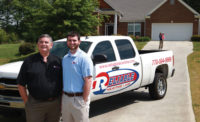Converting constant-volume package rooftop units to variable-volume operations can have a significant impact on energy consumption. Since their creation, package rooftop units (RTUs) have been designed to operate at either zero or 100 percent.

|
| Ryan Rex |
An RTU is defined as an air handler that is designed for outdoor use, typically on roofs. The science of these units has remained basically unchanged since the invention of electromechanical cooling by Willis Carrier back in 1902. Although the idea isn’t much different than having forced air blow over coils to condition the indoor air while removing humidity, the design of the air handler has changed over time. Most of the units now include steel framing, insulated panels and filters, heating/cooling elements, a mixing chamber, and a supply fan. Almost all units incorporate fresh air to combat sick building syndrome, and high carbon dioxide levels indoors. This is typically accomplished using a basic damper or an economizer controlled with air sensors.
Although the types of refrigerants have changed (a lot) since the inception of what we call air conditioning, the actual refrigeration cycle is arguably the same as it was in the beginning. Consisting of a condensing coil, metering device, evaporator coil, and compressor, the refrigeration cycle is a little more than a mechanical device of energy transfer.
The process of energy transfer is a combination of all of the components of both the air handler itself and the refrigeration cycle. This harmony of mechanically operating devices and the physics of the refrigerant is what keeps us comfortable every day. The
last part is the most important. Without that reliable level of comfort, our modern world would be thrown into disarray. Air conditioning was once considered a luxury, but the days of when we worked in hot buildings all year long are over. It is now a necessity, especially in commercial buildings without operable windows. Without it, people would be passing out daily from heat exhaustion and a lack of fresh air. It would be absolute chaos. So if the process of air conditioning is so great, and if it has remained virtually unchanged since it was first created by Carrier, than why change it at all?
One could start by making the old argument, “If it ain’t broke then don’t try to fix it.” This argument was once a crowd pleaser and an easy out for anyone who just didn’t care. It was the best way to tell others that what they have is good enough so just accept it and move on. Well, those days are gone, too. We have a great and many things to worry about now beyond what were considered problems in the days of our parents. One thing, for instance, is energy consumption or the reduction thereof.
Global warming and climate change are becoming household terms. The science of each has been proven by more than 98 percent of all who have researched the topics. Is it us causing these problems or are they natural occurrences? I could make arguments for both, but the fact is that globalization and over population is speeding up the process. So I ask you, what’s the solution? If the problem is bigger than you and I, what can we do to help? Actually, in the HVACR industry, we can do a lot. We can do more than most, actually.
Mechanical cooling units consume up to 50 percent of the total energy used by commercial buildings. More than two-thirds of these buildings are conditioned with RTUs. The vast majority of these buildings with RTUs were built more than 30 years ago during a time when the informal norm was, “hey, if we need one, let’s throw in two.” This may sound anecdotal, but studies have shown that some buildings from those days have RTUs that are nearly 75 percent oversized, and waste far more energy than I’d like to admit. People have been literally throwing money out the window for generations, and we are finally making a move to put a stop to it.
It all starts when we consider how much mechanical cooling is needed to condition a space. We can figure this out based on occupancy and temperature. When it’s determined how much cooling is needed to satisfy the space temperature during the peak occupied schedule, we can compare those values to the existing design.
One important factor that we need to remember before getting into energy reduction is how much fresh air is needed at any given time. Local codes always overrule any suggested design standards, but for argument’s sake, minimum settings of 10 percent outside air with 30 percent supply fan speed is a safe bet.
Taking into consideration the desired space temperature, occupancy levels, outside air, and static pressure minimums, we can now begin to consider the option of cycling down the RTU to save energy without sacrificing the personal climate of the occupants.
So where do we begin? How do we go about creating savings when taking all this into consideration? The most tested and proven method is to convert a constant-volume unit into a variable-volume unit. This can be done to virtually any RTU that isn’t on the verge of falling apart. By installing a variable-frequency drive (VFD) on the blower motor, you can safely slow down the fan speed. Although this sounds relatively easy to do, it isn’t. There are companies out there who have devoted countless engineering hours and research dollars to design retrofit devices that accomplish this goal, but these devices include far more than just a VFD.
Slowing down the fan is just a single variable in the equation. You also have to take into account the amount of static pressure it takes to move the air to the end of the ducts, supply/return/mixed air temperatures, and compressor staging. Some companies out there are building RTUs with compressors that can be converted to variable-speed operation. Most of the older RTUs use one or more compressor(s) and stage them accordingly. Controlling the compressor staging can be a highly difficult task, but the science is there, and it’s been heavily tested.
Converting a constant-volume RTU to variable volume can save anywhere between 20-50 percent in energy savings if done correctly. There have even been documented cases of up to 70 percent savings in some applications. The market seems to be primed and ready for these changes to take hold. The problem is most people don’t understand the benefits just yet, which means it’s up to us to raise awareness by educating our customers about the benefits of energy-saving techniques. Without this change awareness, the equipment we service will essentially be stuck in a short cycle.
Publication date: 11/4/2013
Want more HVAC industry news and information? Join The NEWS on Facebook, Twitter, and LinkedIn today!








